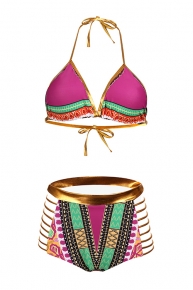The idea of sun protection and swimwear may sound contradictory or remind us of the Victorian era swimsuits with their frilly bloomers, swim caps, and swimming shirts with sleeves down to the elbow. The 19th century Europeans and North Americans actually had an edge on us when it comes to sun protective Sexy Bikinis Swimsuits . It was during the 1920s that we switched over to swimwear that showcased more skin. With the rise of skin cancer and better understanding of ultraviolet radiation from the sun, we have come to understand that the more skin we expose to the sun, the more skin we put at risk for sun damage.
Regular fabrics, including non-swimwear, provide very little protection from the sun’s rays. In fact, most summer fabrics offer an Ultraviolet Protection Factor (UPF) of only 5, which allows much harmful radiation to pass through the fabric and hit the skin. The UPF is a new rating system for sun protective swimwear and fabrics. It measures both UVA and UVB rays and provides protection against both. Sun protective textiles are manufactured in both swimwear and other non-swimwear pieces.

The fabrics incorporate a tighter fabric weave and styles to protect more susceptible areas of skin. These specialized garments for protective sun wear have a rating scale of 10-50+, and some brands can block up to 99% of the sun’s harming rays. The best swimwear brands utilize a high quality nylon-lycra blend with a UPF of 50+ for maximum sun protection. This rating means that your skin is 50 times more protected against UV radiation than your naked skin. Only 1/50th of the radiation is able to pass through the garment, providing you with only 1-2% exposure of UV rays.
Skin damage from the sun can be minimized, and skin cancers in particular are preventable with proper protection from harmful UV rays. Utilizing sun protective swimwear and other clothing, even during cloudy days, plus applying sunblock and wearing hats and glasses will help ensure that your skin is not unnecessarily exposed to damaging rays. Also remembering to stay inside between the hours of 10am and 2pm will reduce your exposure to the sun’s most powerful rays. Taking these simple precautions will help protect you from skin cancer, premature skin aging, and other conditions associated with sun overexposure. You can prevent yourself from being a victim of skin cancer by simply being mindful of your skin’s exposure to the sun.